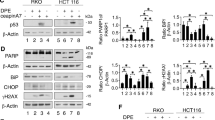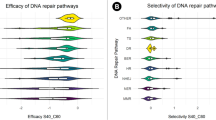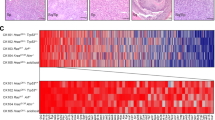Abstract
Oncogenic stimuli trigger the DNA damage response (DDR) and induction of the alternative reading frame (ARF) tumor suppressor, both of which can activate the p53 pathway and provide intrinsic barriers to tumor progression. However, the respective timeframes and signal thresholds for ARF induction and DDR activation during tumorigenesis remain elusive. Here, these issues were addressed by analyses of mouse models of urinary bladder, colon, pancreatic and skin premalignant and malignant lesions. Consistently, ARF expression occurred at a later stage of tumor progression than activation of the DDR or p16INK4A, a tumor-suppressor gene overlapping with ARF. Analogous results were obtained in several human clinical settings, including early and progressive lesions of the urinary bladder, head and neck, skin and pancreas. Mechanistic analyses of epithelial and fibroblast cell models exposed to various oncogenes showed that the delayed upregulation of ARF reflected a requirement for a higher, transcriptionally based threshold of oncogenic stress, elicited by at least two oncogenic ‘hits’, compared with lower activation threshold for DDR. We propose that relative to DDR activation, ARF provides a complementary and delayed barrier to tumor development, responding to more robust stimuli of escalating oncogenic overload.
Similar content being viewed by others
Log in or create a free account to read this content
Gain free access to this article, as well as selected content from this journal and more on nature.com
or
Abbreviations
- AOM:
-
azoxymethane
- ARF:
-
alternative reading frame
- ChIP:
-
chromatin immunoprecipitation
- DABG:
-
detection above background
- DDR:
-
DNA damage response
- DMEM:
-
Dulbecco’s modified Eagle’s medium
- DSS:
-
dextran-sodium-sulfate
- Ha-Ras Q61L:
-
amino-acid substitution at position 61 in Ha-RAS from glutamine (Q) to leucine (L)
- HBEC:
-
human bronchial epithelial cell
- hTERT:
-
human telomerase reverse transcriptase
- Ncstn−/−:
-
homozygous conditional nicastrin deletion
- PanIN:
-
pancreatic intraepithelial neoplasia
- pT68-Chk2:
-
phosphorylated at Thr68 Chk2
- Sa-β-gal:
-
senescence associated β-galactosidase
- siRNA:
-
small interfering RNA
- γH2AX:
-
phosphorylated at Ser139 Histone H2AX
- ATM-p:
-
phosphorylated at Ser1981 ATM
References
Halazonetis TD, Gorgoulis VG, Bartek J . An oncogene-induced DNA damage model for cancer development. Science 2008; 319: 1352–1355.
Gil J, Peters G . Regulation of the INK4b–ARF–INK4a tumour suppressor locus: all for one or one for all. Nat Rev Mol Cell Biol 2006; 7: 667–677.
Gorgoulis VG, Halazonetis TD . Oncogene-induced senescence: the bright and dark side of the response. Curr Opin Cell Biol 2010; 22: 816–827.
Collado M, Serrano M . Senescence in tumours: evidence from mice and humans. Nat Rev Cancer 2010; 10: 51–57.
Zilfou JT, Lowe SW . Tumor suppressive functions of p53. Cold Spring Harb Perspect Biol 2009; 1: a001883.
Negrini S, Gorgoulis VG, Halazonetis TD . Genomic instability—an evolving hallmark of cancer. Nat Rev Mol Cell Biol 2010; 11: 220–228.
Bartkova J, Horejsí Z, Koed K, Krämer A, Tort F, Zieger K et al. DNA damage response as a candidate anti-cancer barrier in early human tumorigenesis. Nature 2005; 434: 864–870.
Gorgoulis VG, Vassiliou LV, Karakaidos P, Zacharatos P, Kotsinas A, Liloglou T et al. Activation of the DNA damage checkpoint and genomic instability in human precancerous lesions. Nature 2005; 434: 907–913.
Bartkova J, Rezaei N, Liontos M, Karakaidos P, Kletsas D, Issaeva N et al. Oncogene-induced senescence is part of the tumorigenesis barrier imposed by DNA damage checkpoints. Nature 2006; 444: 633–637.
Di Micco R, Fumagalli M, Cicalese A, Piccinin S, Gasparini P, Luise C et al. Oncogene-induced senescence is a DNA damage response triggered by DNA hyper-replication. Nature 2006; 444: 638–642.
Liontos M, Koutsami M, Sideridou M, Evangelou K, Kletsas D, Levy B et al. Deregulated overexpression of hCdt1 and hCdc6 promotes malignant behavior. Cancer Res 2007; 67: 10899–10909.
Sherr CJ, Weber JD . The ARF/p53 pathway. Curr Opin Genet Dev 2000; 10: 94–99.
Sherr CJ . Ink4-Arf locus in cancer and aging. Wiley Interdiscip Rev Dev Biol 2012; 1: 731–741.
Hoeijmakers JH . Genome maintenance mechanisms for preventing cancer. Nature 2001; 411: 366–374.
Jackson SP, Bartek J . The DNA-damage response in human biology and disease. Nature 2009; 461: 1071–1078.
Branzei D, Foiani M . Maintaining genome stability at the replication fork. Nat Rev Mol Cell Biol 2010; 11: 208–219.
Kim WY, Sharpless NE . The regulation of INK4/ARF in cancer and aging. Cell 2006; 127: 265–275.
Mo L, Zheng X, Huang HY, Shapiro E, Lepor H, Cordon-Cardo C et al. Hyperactivation of Ha-ras oncogene, but not Ink4a/Arf deficiency, triggers bladder tumorigenesis. J Clin Invest 2007; 117: 314–325.
Wirtz S, Neufert C, Weigmann B, Neurath MF . Chemically induced mouse models of intestinal inflammation. Nat Protoc 2007; 2: 541–546.
Chen J, Huang XF . The signal pathways in azoxymethane-induced colon cancer and preventive implications. Cancer Biol Ther 2009; 8: 1313–1317.
Wang QS, Papanikolaou A, Nambiar PR, Rosenberg DW . Differential expression of p16(INK4a) in azoxymethane-induced mouse colon tumorigenesis. Mol Carcinog 2000; 28: 139–147.
Ekbom A, Helmick C, Zack M, Adami HO . Ulcerative colitis and colorectal cancer. N Engl J Med 1990; 323: 1228–1233.
Borinstein SC, Conerly M, Dzieciatkowski S, Biswas S, Washington MK, Trobridge P et al. Aberrant DNA methylation occurs in colon neoplasms arising in the azoxymethane colon cancer model. Mol Carcinog 2010; 49: 94–103.
Peng DF, Kanai Y, Sawada M, Ushijima S, Hiraoka N, Kitazawa S et al. DNA methylation of multiple tumor-related genes in association with overexpression of DNA methyltransferase 1 (DNMT1) during multistage carcinogenesis of the pancreas. Carcinogenesis 2006; 27: 1160–1168.
Artavanis-Tsakonas S, Rand MD, Lake RJ . Notch signaling: cell fate control and signal integration in development. Science 1999; 284: 770–776.
Nicolas M, Wolfer A, Raj K, Kummer JA, Mill P, van Noort M et al. Notch1 functions as a tumor suppressor in mouse skin. Nat Genet 2003; 33: 416–421.
Sarkar S, Jülicher KP, Burger MS, Della Valle V, Larsen CJ, Yeager TR et al. Different combinations of genetic/epigenetic alterations inactivate the p53 and pRb pathways in invasive human bladder cancers. Cancer Res 2000; 60: 3862–3871.
Vikhanskaya F, Kei Lee M, Mazzoletti M, Broggini M, Sabapathy K . Cancer-derived p53 mutants suppress p53-target gene expression—potential mechanism for gain of function of mutant p53. Nucleic Acids Res 2007; 35: 2093–2104.
Schulz WA . Understanding urothelial carcinoma through cancer pathways. Int J Cancer 2006; 119: 1513–1518.
Makitie AA, Monni O . Molecular profiling of laryngeal cancer. Expert Rev Anticancer Ther 2009; 9: 1251–1260.
Yanofsky VR, Mercer SE, Phelps RG . Histopathological variants of cutaneous squamous cell carcinoma. J Skin Cancer 2011; 2011: 210813.
Rünger TM, Vergilis I, Sarkar P, DePinho RA, Sharpless NE . How disruption of cell cycle regulating genes might predispose to sun-induced skin cancer. Cell Cycle 2005; 4: 643–645.
Ramirez RD, Sheridan S, Girard L, Sato M, Kim Y, Pollack J et al. Immortalization of human bronchial epithelial cells in the absence of viral oncoproteins. Cancer Res 2004; 64: 9027–9034.
Sato M, Vaughan MB, Girard L, Peyton M, Lee W, Shames DS et al. Multiple oncogenic changes (K-RAS(V12), p53 knockdown, mutant EGFRs, p16 bypass, telomerase) are not sufficient to confer a full malignant phenotype on human bronchial epithelial cells. Cancer Res 2006; 66: 2116–2128.
Robertson KD, Jones PA . The human ARF cell cycle regulatory gene promoter is a CpG island which can be silenced by DNA methylation and down-regulated by wild-type p53. Mol Cell Biol 1998; 18: 6457–6473.
Inoue K, Roussel MF, Sherr CJ . Induction of ARF tumor suppressor gene expression and cell cycle arrest by transcription factor DMP1. Proc Natl Acad Sci USA 1999; 96: 3993–3998.
Berkovich E, Lamed Y, Ginsberg D . E2F and Ras synergize in transcriptionally activating p14ARF expression. Cell Cycle 2003; 2: 127–133.
Tsantoulis PK, Gorgoulis VG . Involvement of E2F transcription factor family in cancer. Eur J Cancer 2005; 41: 2403–2414.
del Arroyo AG, El Messaoudi S, Clark PA, James M, Stott F, Bracken A et al. E2F-dependent induction of p14ARF during cell cycle re-entry in human T cells. Cell Cycle 2007; 6: 2697–2705.
Inoue K, Mallakin A, Frazier DP . Dmp1 and tumor suppression. Oncogene 2007; 26: 4329–4335.
Bates S, Phillips AC, Clark PA, Stott F, Peters G, Ludwig RL et al. p14ARF links the tumour suppressors RB and p53. Nature 1998; 395: 124–125.
Nikolaev SI, Sotiriou SK, Pateras IS, Santoni F, Sougioultzis S, Edgren H et al. A single-nucleotide substitution mutator phenotype revealed by exome sequencing of human colon adenomas. Cancer Res 2012; 72: 6279–6689.
Burrell RA, McClelland SE, Endesfelder D, Groth P, Weller MC, Shaikh N et al. Replication stress links structural and numerical cancer chromosomal instability. Nature 2013; 494: 492–496.
Bartek J, Mistrik M, Bartkova J . Thresholds of replication stress signaling in cancer development and treatment. Nat Struct Mol Biol 2012; 19: 5–7.
Bermejo R, Lai MS, Foiani M . Preventing replication stress to maintain genome stability: resolving conflicts between replication and transcription. Mol Cell 2012; 45: 710–718.
Stott FJ, Bates S, James MC, McConnell BB, Starborg M, Brookes S et al. The alternative product from the human CDKN2A locus, p14(ARF), participates in a regulatory feedback loop with p53 and MDM2. EMBO J 1998; 17: 5001–5014.
Berkovich E, Ginsberg D . Ras induces elevation of E2F-1 mRNA levels. J Biol Chem 2001; 276: 42851–42856.
Haupt Y . Certainly no ARF terthought: oncogenic cooperation in ARF induction a key step in tumor suppression. Cell Cycle 2003; 2: 113–115.
Sarkisian CJ, Keister BA, Stairs DB, Boxer RB, Moody SE, Chodosh LA . Dose-dependent oncogen-induced senescence in vivo and its evasion during mammary tumorigenesis. Nat Cell Biol 2007; 9: 493–505.
Murphy DJ, Junttila MR, Pouyet L, Karnezis A, Shchors K, Bui DA et al. Distinct thresholds govern Myc’s biological output in vivo. Cancer Cell 2008; 14: 447–457.
Zhu D, Xu G, Ghandhi S, Hubbard K . Modulation of the expression of p16INK4a and p14ARF by hnRNP A1 and A2 RNA binding proteins: Implications for cellular senescence. J Cell Physiol 2002; 193: 19–25.
Lal A, Kim HH, Abdelmohsen K, Kuwano Y, Pullmann R Jr, Srikantan S et al. p16INK4a translation suppressed by miR-24. PLoS One 2008; 3: e1864.
Iwasa H, Han J, Ishikawa F . Mitogen-activated protein kinase p38 defines the common senescence-signalling pathway. Genes Cells 2003; 8: 131–144.
Bulavin DV, Phillips C, Nannenga B, Timofeev O, Donehower LA, Anderson CW et al. Inactivation of the Wip1 phosphatase inhibits mammary tumorigenesis through p38 MAPK-mediated activation of the p16Ink4a-p19 Arf pathway. Nat Genet 2004; 36: 343–350.
Ito K, Hirao A, Arai F, Takubo K, Matsuoka S, Miyamoto K et al. Reactive oxygen species act through p38 MAPK to limit the lifespan of hematopoietic stem cells. Nat Med 2006; 12: 446–451.
Chang L, Karin M . Mammalian MAP kinase signaling cascades. Nature 2001; 410: 37–40.
Ohtani N, Zebedee Z, Huot TJ, Stinson JA, Sugimoto M, Ohashi Y et al. Opposing effects of Ets and Id proteins on p16INK4a expression during cellular senescence. Nature 2001; 409: 1067–1070.
Ortega S, Malumbres M, Barbacid M . Cyclin D-dependent kinases, INK4 inhibitors and cancer. BBA-Rev Cancer 2002; 1602: 73–87.
Zindy F, Quelle DE, Roussel MF, Sherr CJ . Expression of the p16(INK4a) tumor suppressor versus other INK4 family members during mouse development and aging. Oncogene 1997; 15: 203–211.
Krishnamurthy J, Torrice C, Ramsey MR, Kovalev GI, Al-Regaiey K, Su L et al. Ink4a/Arf expression is a biomarker of aging. J Clin Invest 2004; 114: 1299–1307.
Acknowledgements
We thank Proffessor M Oren for kindly providing the CM5 antibody and the anti-p53 siRNA, Dr. PP Pandolfi for kindly donating plasmids pGL2-p19ARF-Luc and p14ARF-Luc, Dr. Robert Strauss for donating plasmids shp53 pLKO.1 hygro and Dr. A Damalas and Antonia Daleziou for their technical support. Financial support was from the Danish Cancer Society, the Danish National Research Foundation, the European Commission FP7 projects: GENICA, INFLA-CARE, BioMedReg, DDResponse, INsPiRE and the NKUA-SARG projects (codes: 11351 and 8916). VG and MP are recipients of a Hellenic Association for Molecular Cancer Research scholarship, whereas Dr. A Kotsinas received an Empeirikeion Foundation fellowship.
Author information
Authors and Affiliations
Corresponding authors
Ethics declarations
Competing interests
The authors declare no conflict of interest.
Additional information
Edited by G Melino
Supplementary Information accompanies this paper on Cell Death and Differentiation website
Supplementary information
Rights and permissions
About this article
Cite this article
Evangelou, K., Bartkova, J., Kotsinas, A. et al. The DNA damage checkpoint precedes activation of ARF in response to escalating oncogenic stress during tumorigenesis. Cell Death Differ 20, 1485–1497 (2013). https://doi.org/10.1038/cdd.2013.76
Received:
Revised:
Accepted:
Published:
Issue date:
DOI: https://doi.org/10.1038/cdd.2013.76
Keywords
This article is cited by
-
A prototypical non-malignant epithelial model to study genome dynamics and concurrently monitor micro-RNAs and proteins in situ during oncogene-induced senescence
BMC Genomics (2018)
-
Tumors overexpressing RNF168 show altered DNA repair and responses to genotoxic treatments, genomic instability and resistance to proteotoxic stress
Oncogene (2017)
-
WSB1 overcomes oncogene-induced senescence by targeting ATM for degradation
Cell Research (2017)
-
p19Arf is required for the cellular response to chronic DNA damage
Oncogene (2016)
-
IFNγ induces oxidative stress, DNA damage and tumor cell senescence via TGFβ/SMAD signaling-dependent induction of Nox4 and suppression of ANT2
Oncogene (2016)



